Appendix
The surname CHENOT and its variants
Our family name came over from France as CHÉNOT (see Nicolas Chenot’s signature, below). It is derived from an Old French word (chesne) for “oak.” In the United States this surname developed several variant spellings.
As noted earlier, the Chenot household appears in the 1840 census in New York City’s 6th ward, with Nicolas’s surname recorded as “Chinott.”
In the record of Louis Shenot’s marriage to Rosalie Le Clair, his name was written as “Chinôt.” This was likely the priest’s misinterpretation or his attempt to make the name look as French as possible.
In at least two instances, the Chenot surname was used in association with Louis himself and with his children. When Rosalie (Le Clair) Shenot gave birth to their first child in June 1877, this child’s name was recorded in the city of New York as Rosalie Chenot, the daughter of Louis Chenot and Rosalie Le Clair. Calvary Cemetery recorded the burial of Agnes Chenot, age one year, on October 13, 1884, in the same grave where Louis’s first wife Hannah was interred. All the circumstantial evidence points to Agnes being Louis and Rosalie’s daughter.
Throughout most of his life, however, Louis preferred to spell his surname “Shenot,” an anglicized form that survived through the family of his younger son, Louis Charles. Records from Louis’s military service preserved his name once as “Schenaut” and twice as “Shenott.” The birth records of Louis’s two eldest children, Louisa and Joseph, listed their surnames as Shenott and Shinett, respectively.
In the first of the two 1870 census records taken in New York City, Louis’s last name was recorded as Smith!
Some of these variations are misspellings, bad handwriting, or an inability to deal with French surnames; but others are not. Louisa Shenot’s 1892 marriage record preserves her surname as Cheno; Jennie Shenot’s interment record of January 1900 lists her surname as Shenott. Louis’s older son, Joseph Francis, signed his marriage record in 1891 as “Joseph Scheno,” but later restored the final (silent) T in a form that merged the original spelling with his father’s version. Through the years, several of Joseph F. Schenot’s descendants, including Robert C. Schenot, Jr. (Bob Scheno), have chosen to dispense with – and truly silence – that problematic final T.
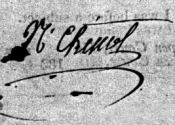
LEFT: Nicolas Chenot’s signature on his naturalization document. It appears from more than one record that Nicolas normally wrote his name with an accent mark: “Chénot.” Gravestones in the Trondes cemetery are marked with this surname exactly as Nicolas wrote it. This may be why it is sometimes interpreted as “Chinot” – the accented e resembles a dotted i.
Nicolas Chenot and his family
Both Nicolas and his son Joseph applied for and received naturalization as citizens of the United States.
Nicolas became a US citizen on September 26, 1839, through the Marine Court of New York City. His address was given simply as New York City; a man named Prosper Douglass served as witness. The 1839-40 directory for New York City lists a Prosper Douglas whose occupation was that of “interpreter.”
Son Joseph became a US citizen on the 5th of November 1844, through the Common Pleas Court of New York County. His witness was “Nicholas Chenot,” listed as living at the same address as Joseph – 272 Walker Street, NYC. This locale matches the 1840 census listing for the family: Walker Street was on the northern edge of the notorious 6th ward, described by Herbert Asbury in his 1927-28 book The Gangs of New York and immortalized in 2002 by a movie of the same name.
We have no further documentary evidence of Nicolas Chenot’s life beyond November 5, 1844, when he witnessed his son Joseph’s naturalization.
The 1860 US census recorded what appears to be the Chenot family living in the 8th ward of New York City (just north of the 6th ward). Living in a multi-family (probably tenement) dwelling were “May,” Joseph, and Lewis Sheano, all listed as having been born in France. We strongly suspect we have the right family here for several reasons.
The apparently phonetic spelling of Chenot as “Shea-no” reflects a familiarity with Irish surname spellings, if not the likely Irish background of the census taker himself. “May” looks to us like “Mary” written in sloppy handwriting. Marie Chenot would have been 56 years of age by 1860; “May” was listed as 53 years old. Joseph Chenot would have been about 36, quite a bit older than Joseph Sheano, listed as 22 years old. Louis, most likely born in 1838, would have been 22, not 18 years old as Lewis Sheano was listed. While the family members’ ages are not accurate, they do reflect the spread we would expect.

Most remarkable about this particular 1860 census record is the spelling of Louis’s name as “Lewis.” We know that Louis preferred the anglicized spelling of his given name and represented himself as such through most of his adult life. Also, Louis lived for many years in New York City’s 8th ward. Finding the Chenot family in this part of the city in 1860 fits the overall pattern of data. That Louis was listed as born in France is not surprising, given that he spoke French. Later records indicate clearly that Louis was born in New York.
We don’t know when or where Nicolas Chenot and his wife Marie died, nor do we know where they’re buried. If our information is correct, we may presume that Nicolas died prior to the taking of the 1860 census. In the 1870 census we found a listing for a “Mary Chenot,” age 65, born in France, living in the 12th ward of Jersey City, Hudson county, New Jersey. This woman is the right age to have been Marie (Gagneur) Chenot. Is she “ours?” We don’t know.

Louis Shenot’s older brother Joseph
Beyond his listing in the 1860 census as discussed above, we know nothing further about Joseph Chenot. Joseph’s naturalization papers ended up in the stash of French documents, letters, and recipes that were handed down through Louis’s family. Joseph may have died between 1860 and 1870, possibly during the Civil War.
Civil War service records for New York mention a man named Joseph Chenot, whose age at enlistment seems far too young to have been Louis’s brother. This Joseph Chenot, who enlisted at age 30 in 1861, would have been born circa 1831; Louis’s brother Joseph was born in September 1823. If Louis’s brother was the same Joseph Chenot who enlisted in Staten Island into the Union army, then we have a bit more color in our family history: This Joseph Chenot deserted from one regiment and joined a different one soon after.
On August 23, 1861, Joseph D. Chenot enlisted in the Union Army on Staten Island, NY. Five days later he joined Company F of the 55th Infantry Regiment of New York at the rank of private. Records indicate that Corporal Joseph Chenot deserted the 55th on December 1, 1862, in New York City. About three weeks later, Joseph “transferred” into New York’s 38th Infantry Regiment, Company G, as a private; his rank upon discharge from the 38th was that of private.
We don’t find any dates for Joseph’s term of service with Company E of the 40th NY infantry. Joseph Chenot joined the 40th at the rank of private, but there is no mention of his rank at discharge. Might Joseph have died during this tour of duty? We can only wonder what became of him.
Louis Shenot’s unnamed brother
Two boys under the age of five resided in the household of Nicolas Chenot, according to the 1840 census for New York City. Louis Shenot was one of these children. We do not know who the other boy was; but US federal census records contain an intriguing possibility.
“T. F. Chenot” was listed in the 1880 census as living in Grant, Multnomah county, Oregon, with his English-born wife, “M. J.”
Directories for Portland, Oregon, suggest that this man’s name was actually Peter F. Chenot:
Database: Portland, Oregon Directories, 1890-91
Name: Mary J Chenot (widow Peter F)
Location: 20th s w corner Powell Valley rd.
Year: 1891
City: East Portland
State: OR
Mary J Chenot (widow Peter F) 20th s w corner Powell Valley rd.
Mary J Chanot (widow Peter F) west side 20th near Powell Valley rd.
According to the 1880 census, Mr. Chenot was born in New York and was forty-four years old (born circa 1836). The birthplace for both of Mr. Chenot’s parents was listed as France. This puts him in the right place, at the right time, with the right parentage, to have been Louis’s brother. But the real kicker is Mr. Chenot’s occupation, which was listed as “Boiler Maker” – the very same line of work pursued by Louis Shenot for many years.
We have no more information with which to prove or disprove our little theory. But we think this is a remarkably compelling piece of data!
Louis Shenot’s Civil War service
Louis’s first enlistment came on May 12, 1861, when he joined Company H, 69th Regiment of the New York State Militia. A website that calls itself the Civil War Archive has accounts of the activity of each of the units with which Louis served.
Louis’ name appears in the muster rolls for this enlistment as follows:
SHENOTT, Lewis
Company: H Unit: 69 N. Y. State Militia
Rank In: Private Rank Out: Private
National Archives Microfilm Box, Roll, and Record: 000551, 0127, 00003404
In his first enlistment Louis Shenot joined the “Irish Brigade,” commanded by Colonel Michael Corcoran. The 69th New York State Militia was present at the battle of 1st Bull Run (Manassas), in which Colonel Corcoran was wounded. A History of the 69th New York can be found at this website.
Louis Shenot was honorably discharged from – or “mustered out” of – the 69th New York State Militia in New York City in August 1861.
His first experience as a soldier couldn’t have been all bad, because Louis re-enlisted the very next summer. On May 29, 1862, he joined Company I, 8th Regiment of the New York State Militia (Infantry). The Civil War Archive website identifies this regiment as the “8th Regiment National Guard Infantry.”
Louis Shenot was honorably discharged in New York City on September 10, 1862. His name appears in the muster rolls for this re-enlistment:
SHENOTT, Lewis
Company: I Unit: 8 N. Y. State Militia
Rank In: Private Rank Out: Private
National Archives Microfilm Box, Roll, and Record: 000551, 0127, 00003403
Louis’ last re-enlistment came the next summer, when he was mustered into Company F, 37th Regiment, New York State Militia (Infantry) on June 18, 1863. His final tour of duty was also the shortest: Louis was honorably discharged on July 22, 1863. The Civil War Archive website identifies this regiment as the “37th Regiment National Guard Infantry.”
This is the only enlistment for which we have not yet found Louis’s name on a muster roll index. His pension documents, which were written mostly in longhand by various officials, indicate in at least two places that he was listed for his service with the 37th Regiment as Lewis “Schnant” or “Schenant” or “Schenaut.” For obvious reasons we suspect spelling, handwriting, and/or transcription differences may be the reason we can’t find Louis’s name. It’s always possible, too, that the original muster roll documents were lost, damaged, or destroyed.
What a “Boiler Maker” Does
Louis Shenot worked as a boiler maker for much of his life. We looked around for a definition of this line of work and found a job description at this website. This description is a more modern one – we doubt, for example, that pneumatic hammers were in use in mid-19th century New York City – but it paints an interesting picture of the work. Another website, one listing various Victorian era occupations, defines a boiler maker as a person who “made boilers, or general metalworker.”
Joseph Francis Schenot
Joseph Schenot talked a bit about his family to his grandson, Bob Scheno, when Bob was a boy. (Bob supplied us with the knowledge that Grandpa Joe always spoke his own father’s given name with the French pronunciation – “Lou-EE.”) Here is some of what Bob wrote to us about his recollections:
I have a memory of my grandfather sitting in a rocking chair in the kitchen of our home on 12th Street in Union City [NJ] when I was about 10 years old and talking to me about his childhood in New York. He told me that he knew a few expressions in French that he learned from his father, such as, “Comment ce va?” and “Comment allez-vous?” (both expressions of greeting: “How are you?”). I asked him if his father spoke French and he said he did and sometimes had trouble understanding English. He told me his father often would ask him in French, “Qu’est qu’il dit?” (What did he say?) when someone was speaking around him in English.
It was a long time ago, and Grandpa rarely spoke about his family during those years when he lived with us prior to his death in 1943.
If we value truth in our family history, we must acknowledge here that Joseph F. Schenot was not remembered fondly by either his sister-in-law Annie (Winter) (Hagerty) Ranich or his half-brother Louis Charles Shenot. Joseph had distinct problems in the area of love relationships. His difficulties centered on a need for feminine attention, a need so great that it trumped everything else.
Joseph was only seven years old when his mother died. It’s likely this traumatic loss was compounded by his father’s quick remarriage to a young woman who routinely spoke French. Joseph, still grieving for his mother, found himself in a household in which English was no longer the primary language. We suspect Joseph may have rebelled against this situation and against his teenaged stepmother. We know that Joseph’s alienation affected his entire adult life.
As we describe here the life of Joseph Francis Schenot, we do so with compassion, in the manner demonstrated by Joseph’s son Robert, who gave his elderly father a home and cared for him until he died.
Bob Scheno told us his grandfather Joseph F. Schenot was about 5 feet 9 inches tall, that he played the harmonica “beautifully” and liked to sing folk songs. Joseph’s customary occupation, per family lore and census data, was that of glass blower, polisher, and beveller. Bob recalled that Joseph beveled the edges of mirror glass and the glass pieces that were set into clock faces.
The untimely death of Joseph’s wife Mary in 1907 provoked bitter words from Mary’s sister Annie – “if only he hadn’t forced himself on her!”
Our original thoughts about Annie’s remark were that Mary likely was pregnant when she died; and that childbearing had taken a toll on her. Data from daughter Anna’s 1899 birth record and from the 1900 census indicate that Mary Schenot had given birth to five children, three of whom survived. Son Robert Charles, born in 1901, would have been Mary’s sixth baby.
Now we think it possible that Mary’s death from cardiac arrest at age 32 was due to an air embolism caused by an illegal abortion procedure. That grim scenario fits only too well with Annie’s words.
At the time of their marriage, seventeen-year-old Mary was living at 67 Van Dam Street in New York City, the same address given by twenty-two-year-old Joseph. We don’t know if this was a tenement building where both of them happened to live, or if they were living together. We do know that their eldest child, Louis Herbert, was born July 11, 1891, almost exactly four months after Mary and Joseph made their marriage vows, so it’s safe to say that Mary was pregnant on her wedding day.
It is known that Joseph could be harsh with his children.
Joseph F. Schenot’s secret family
The 1910 census, taken three years after the death of Mary (Winter) Schenot, reveals a secret. Joseph is listed twice in this census year, once in Weehawken with his children Joseph L., Anna, and Robert, boarding in the home of Eliza O’Grady; and again in Hoboken with a wife named Anna and a couple of daughters, two‐year‐old Kate and infant “Annah.” Whether Joseph split his time between Eliza O’Grady’s boarding house and his Newark Street home in Hoboken, or simply warehoused his older children at O’Grady’s, no one knows.
It is known, however, that when Joseph died, a woman – who bore an unmistakable resemblance to him – appeared at his wake, announcing that she was Joseph’s daughter and expressing an interest in the old man’s estate. Bob Scheno, who witnessed this event, sensed from the shocked reactions of his relatives that this woman was a complete stranger to them all. After Robert told her that there was no money, she disappeared and was not heard from again. Until recently, it was assumed that the mystery woman was Joseph’s illegitimate child. It’s probably safe to assume that the woman was Kate or “Annah.”
Did Joseph actually marry the woman listed as his wife in the 1910 census? He did. And obviously he didn’t bother to inform any of his relatives. The New Jersey Marriage Index shows that Joseph Schenot married Anna in 1908. Her surname appears in two different forms: Anna Gresch and Anna Meyer. The state file number is the same for both – 24‐672.
The 1910 census is full of incorrect data on this second marriage, which was indicated as a first marriage by the notation M1. In response to the question “Number of Years of Present Marriage,” someone told the census taker “14.” And the birthplace of Joseph’s parents was given as France rather than New York, suggesting that Anna rather than Joseph himself provided the information to the census taker.
The New Jersey state census for 1915 contains more squirrelly information. The older daughter is still named Kate Schenot (birth date given as February 1908) but the younger daughter “Annah” is not listed. Instead, there’s a child named Frances Meyer (birth date August 1909). A 20‐year‐old named August Wm Meyer (birth date July 1895) resided with them.
Here’s what we have found regarding these people and this situation.
Anna’s maiden name was Gresch. Her first husband was Ernst Meyer, a German immigrant. We located them in the 1905 New Jersey state census. In that year, Ernst Meyer was 64 years old; “Annie” was thirty years his junior. The date given for her birth, January 1871, is close to what was given in the 1915 census. They had one child, a son named August Meyer, born in July 1895. (Bingo.) Further supporting research turned up a birth record for a child named John H. Meyer, born in Hoboken, NJ, in May 1899. (John does not appear in the 1905 New Jersey state census with this family.) The parents’ names: Ernst Meyer and Anna Gresch.
That the elder Schenot daughter Kate was born in 1908 suggests that Joseph fathered this child soon after the death of Mary (Winter) Schenot – assuming that Kate was, in fact, Joseph’s child. That the second daughter was named “Annah” suggests that Wife #2 didn’t know Joseph already had a daughter named Anna with Wife #1.
By 1920, Joseph Schenot was no longer living in this second household. We cannot find Anna and her daughters in that year’s census.
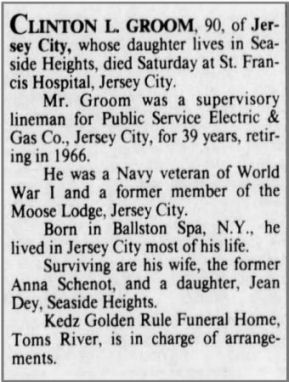
We don’t know what became of Anna (Gresch) (Meyer) Schenot or her daughter Kate. By pure chance we found a reference to the daughter named Anna. Clinton L. Groom’s 1987 obituary named his wife as “the former Anna Schenot.”
Clinton L. Groom went by his middle name, Leslie. On October 19, 1929, in Hoboken, NJ, he wed Anna “Schennett.” The address given for both at the time of their marriage was the same, 709 Willow Ave., Hoboken. (We find this interesting because, in earlier years, some of Joseph’s children from his first marriage lived nearby at 519 Willow Avenue.)
Leslie and Anna Groom had one child, a daughter named Jean Anna. In the US Social Security Applications and Claims Index, 1936‐2007 (an on‐line database accessed at Ancestry.com), Jean’s parents are named as Clinton L. Groom and Anna Meyer. We cannot account for the use of the Meyer surname in this instance, but we know it’s part of this family’s history.
Anna Groom’s own Social Security Death Index info gives her middle initial as F, and a date of birth – August 14, 1910. We believe that the child listed as Frances Meyer in the 1915 New Jersey state census – six years old, born in August 1909 – was Anna Frances Schenot. This fits with the 1910 census listing “Annah” as being eight months old in April of that year.
If Anna F. Schenot wanted to make herself younger by a year, we won’t hold that against her. We’re just grateful that she inadvertently helped us unravel the mystery of her father’s secret second family.
Anna F. (Schenot/Meyer) Groom died on Sunday, July 19, 1992, at the age of 82. Her obituary was truthful about her age; she missed her 83rd birthday by less than a month.
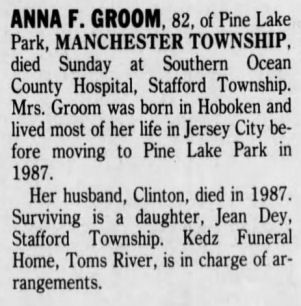
Leslie and Anna Groom’s daughter Jean Anna Groom was born September 17, 1935 in Jersey City, NJ. She married twice, per surname information found in the US Social Security Applications and Claims Index, 1936‐2007 (an on‐line database accessed at Ancestry.com). In November 1956, her surname was Schubert; by March 1971, her surname was Dey.
Jean Dey died on May 12, 2005. Her last residence was listed in the Social Security Death Index as Lakehurst, Ocean county, New Jersey. We don’t know if Jean had any children.
Joseph F. Schenot’s final years
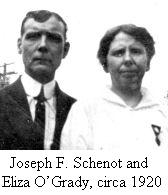
Per the 1920 census, Joseph now lived at 954 Hoboken Street in North Bergen, NJ, with son Robert. Eliza O’Grady, listed as Joseph’s “half-sister,” lived with them. The amusing part of this lie is that the birthplace of both of Eliza’s parents was given as Massachusetts, a truthful response mismatching Joseph’s parents’ birthplace of New York. Did the census taker notice the discrepancy?
Robert Schenot moved out of this household when he married Florence Stover in 1921.
The 1930 census recorded Joseph and Eliza living together in a tenement in Jersey City. Eliza ironed the kinks out of the story this time, listing herself as head of the household, Joseph as her brother, and their parents’ birthplace as Massachusetts. Joseph no longer worked in a glass factory; his occupation now was that of “porter” in a theater. (Bob Scheno recalled that Joseph worked as a porter at the Roosevelt Theater in Union City.)
Joseph was living alone and in poor health by about 1933 when his son Robert brought him to live in his home in Union City. Robert, his wife Florence, and their two children, June and Bob, shared their family life with “Grandpa Joe” for the last ten years of his life. Even so, Bob remembers his grandfather sitting in a chair for hours, speaking to no one. No amount of attention or care seemed to ease Joseph’s depression.
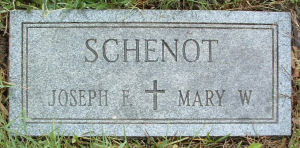
Joseph Schenot died about a month after the early death of Florence Schenot in 1943. Bob Scheno remembered:
He died one morning after I had left for school...my father was with him and I received a message at school to return home. When I arrived home, my father was alone and was cleaning Grandpa’s bedroom. Grandpa had a Mass of Christian Burial from St. Joseph’s Catholic Church, Union City, N.J.... This all happened about a month after my mother passed away in October of that year.
Robert Schenot tended the gravesite of his mother and father for many years before his own death in 1946. A tombstone honoring the memory of Joseph F. and Mary W. Schenot was placed at their gravesite by Robert’s son Bob.
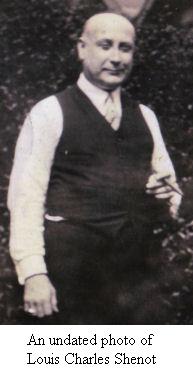
Louis Charles Shenot
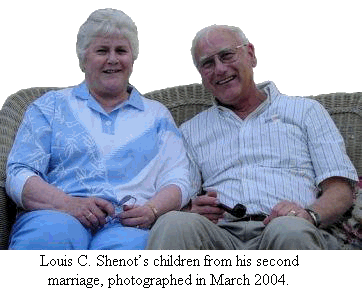
Louis C. Shenot’s daughter from his marriage to Mabel (Merrill) Snider told us that her parents met when her mother’s sister Grace (Alice Grace [Merrill] Nichols) – who was one of Louis C.’s neighbors – introduced them.
And her father loved to garden and to cook. The family had a vegetable garden and fruit trees at their home in Massapequa, on Long Island. The house stood on a huge lot, providing space for chickens, turkeys, and even a pig.
“One sweet memory to share, when Daddy would walk home from work, (train station a mile or so away) we would watch for him. When we saw him, would run towards him, he would open his coat and first one got to walk right inside his coat with him. How super! He sure was a special father.”
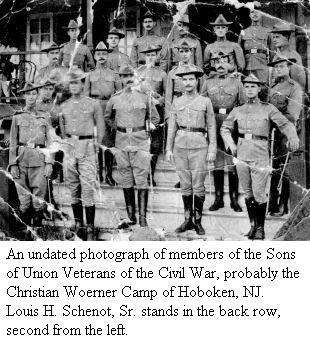
Louis Herbert Schenot, Sr.
The early death of Louis H. Schenot in 1917 prevented much of his family history and his own life story from being told. What we know of Louis H., Sr., was passed down to his children by his widow Clara.
Before he married, Louis H. was a member of the Sons of Union Veterans of the Civil War; his affiliation was through the Christian Woerner Camp, No. 1, that met in Odd Fellows’ Hall in Hoboken, NJ. An item from The Camp News, mentioning the double wedding of “Sister Hagerty” (Aunt Annie) and of Louis H. and Clara, noted also that Louis H., a “former” member, would be returning to the camp and his new wife would join the auxiliary.
Clara Lavery’s home at the time of her marriage to Louis H. was 5802-2nd Avenue in Brooklyn, presumably where she lived with her widowed mother and younger sister. Was it a tough commute between Hoboken and Brooklyn during their courtship?

Bob Scheno’s answer to this question was “...Louis probably took the 14th Street ferry in Hoboken to 42nd Street [in] NYC and then a subway to Brooklyn. Alternatively, he might have taken the ‘Tube’ from Exchange Place, Jersey City, to NYC and then [traveled] by subway to Brooklyn. Hoboken is only one mile long, and a small bus known as a ‘jitney’ went to both the ferry and the Tube. There was also an electric streetcar he might have taken. I would think he would have no problem managing the distance to visit Clara.”
Photos of Louis H. and his family, and a letter written by Louis to Clara just days before his death, reveal a man who loved his wife and children. On August 3, 1917, Louis composed a letter (apparently from the hospital) in shaky handwriting on lined paper. He wrote:
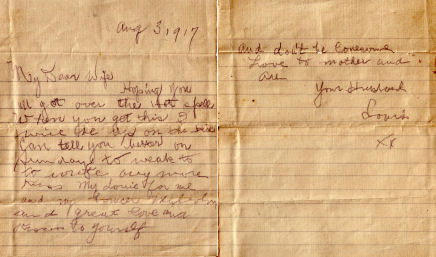
My Dear Wife
Hoping you all got over the hot spell When you get this I will be up on the hill Can tell you better on Sunday
too weak to write any more Kiss my Louie for me and my bouncer Malcolm and great love and kisses to yourself And don’t be lonesome
Love to mother and all
Louis
XX
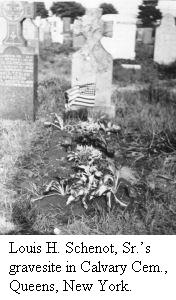
Clara Schenot told her son Malcolm a story about his father’s last days:
Louis and Clara, whose wedding vows had been exchanged in an Episcopalian church, were re-married in a Roman Catholic ceremony as Louis lay on his deathbed. The two children, who had been baptized in an Episcopalian rite, were also given a Catholic baptism. Apparently this was done at the request of Louis’s father, Joseph F. Schenot, a lifelong Catholic. We have found no record of the Catholic rite of matrimony for Louis and Clara. The boys’ Catholic baptisms are on record at St. Paul of the Cross church in Jersey City, NJ, for July 8, 1917, just five weeks before their father’s death.
Clara observed the wishes of her late husband’s family by having Louis buried in a Catholic cemetery. She and her two sons would travel by bus to the cemetery, bringing along pots of geraniums with which to adorn Louis’s grave.
Scarcely three months after Louis’s death, Clara’s mother, Katharine (Patterson) Lavery, died on the 18th of November. Clara didn’t bury her mother next to Hugh Lavery, Clara’s father, in Brooklyn’s Evergreen Cemetery. Instead, Clara somehow finagled her Protestant mother’s burial in the same plot in the Catholic cemetery where her husband was interred. No headstones mark either burial.
Robert Charles Schenot, Sr.
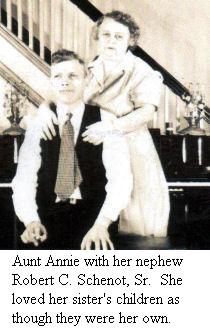
Robert C. Schenot, Sr.’s enduring legacy is one of compassion. Despite numerous childhood hardships, including the early loss of his mother; his father’s inability to show love to his children; and – family lore is unequivocal on this point – the struggle of living in Eliza O’Grady’s boarding house, Robert neither hardened his heart nor succumbed to despair. He would probably thank Aunt Annie for this.
Aunt Annie kept close ties with her niece and nephews, even after she remarried in 1912 and added two more children to her household. She supplied the Schenot siblings with a mother’s love, and possibly saved them from the kind of devastation their father suffered when his own mother died young.
Like Aunt Annie, Robert became an emotional anchor for his deceased brothers’ and sister’s children, and he maintained the family’s connections during his marginally longer lifespan. Robert showed fatherly kindness to his nieces and nephews by encouraging them to finish high school (Robert obtained his own high school education by attending night school). When they graduated, he bought their high school class rings for them. In one of life’s ironic twists, Robert died before Robert, Jr., graduated from high school – before he could give his own son a class ring. When his brother-in-law Henry Spankuch died in 1939, Robert comforted Henry, Jr., asked him whether he needed a suit for the funeral, and helped him buy the clothes he needed.
How Robert took care of his father Joseph during the last decade of Joseph’s life says a great deal about Robert’s character. He strove to give his father a good life, even as Joseph was unresponsive to many of these gifts of love. On a rare occasion when Joseph defended his harsh behavior with excuses of how he’d been victimized himself, Robert was caring but firm in telling him, “No crocodile tears after all these years.” It takes a strong spirit to know where truth and love meet. Robert had such a spirit.
What We Have Learned From Our Shenot/Schenot Cemetery Research:
• • • Use an alias or maiden name when requesting burial records for anyone sharing your own surname or a variant. • • •
In the summer of 2001, we visited Calvary Cemetery in Woodside, NY, to get information on the burial of Louis Shenot. We learned that an interment list for this gravesite would cost $28.
Knowing that Louis H. Schenot, Sr., and his mother-in-law Kate Lavery were buried in another grave at Calvary and that they had no headstone, we asked about what it would take to put a headstone at this gravesite. That was when we found out that past due annual care charges ($829) and a “foundation fee” ($500) must be paid before a stone could be installed. Hmm, maybe not this year....
Later that year we sent a check to Calvary Cemetery for an interment list for the grave where Louis Shenot is buried. The list came with a cover letter from the cemetery Superintendent, saying:
“Upon examination of our records, we find that there are outstanding annual care charges due on this graveholding in the amount of $823.00. A remittance in the amount would be appreciated.
“We recommend that all graveholdings be placed under Perpetual Care. The cost for your graveholding is $1,000.00, in addition to the annual care charges mentioned above. However, if you provide for Perpetual Care at this time, you may eliminate the 2001 annual care charges ($48.00) making the total amount due $1,775.00. This may be paid in a single payment or in installments, at times and in amounts convenient to you, providing that the entire amount is paid within twelve months.”
The cost for our graveholding? At that point in the research, we weren’t even sure we had the right ancestor.
The similarity of Louis’s surname and the name on the $28 check apparently were enough for the folks at Calvary Cemetery to decide we must be Louis’s heirs. Anybody who would spend $28 for a list of five (possibly ancestral) dead people might be interested enough to write an even larger check for decent maintenance care, right? We certainly can’t blame them for trying; but there must be a statute of limitations on how long a family is responsible for its forebears’ debts.
The last burials in “our” graveholding date back to 1899. We decided we could hardly be held accountable for a debt that had accumulated for over one hundred years. Fortunately, no one from Calvary Cemetery has pursued us for the past due charges.
The grave in North Bergen, NJ, where Joseph F. and Mary (Winter) Schenot are buried, was similarly unfunded. The gentleman from Flower Hill Cemetery who responded to our request for information was far more graceful than Calvary Cemetery when he asked for money.
The relative lack of headstones and maintenance funding has become part of the family lore.
Jennie Shenot, who died early in 1900 at not quite twelve years of age, was buried in Green-Wood Cemetery in Brooklyn probably because there was no room left in her father’s graveholding in Calvary Cemetery. More than likely, she lies in an unmarked grave: Jennie’s few surviving relatives were indeed trying to survive and doubtless had no extra money for headstones. We have not yet charted the location of Jennie Shenot’s gravesite. But when and if we do, we will make our inquiry under an assumed name!
© 2018 Elaine Schenot
Sources
Ancestry.com subscription databases:
American Civil War Soldiers
Civil War Service Records
Civil War Pension Index: General Index to Pension Files, 1861-1934
New York City Directories: 1839-1840; 1869; 1890
New York Petitions for Naturalization
North Carolina Deaths, 1983-87
Passenger and Immigration Lists Index, 1500s-1900s
Portland, Oregon Directories, 1890-91
Social Security Death Index (SSDI)
U.S. Public Records Index
U.S. Veterans Cemeteries, ca.1800-2004
World War I Draft Registration Cards, 1917-1918
World War II Army Enlistment Records, 1938-1946
Vital records were obtained from the Municipal Archives, 31 Chambers Street, Room 103, New York, NY 10007
Birth Certificate for Louisa Shenot (“Louisa Shenott”), #2249 – New York City (Manhattan)
Birth Certificate for Joseph F. Schenot (“Joseph Shinett”), #31928 – New York City (Manhattan)
Birth Certificate for Clara Katharine Lavery, #11875 – Brooklyn
Birth Certificate for Anna May Schenot (“Maria Anna May Schanot”), #8582 – Brooklyn
Marriage Certificate for Richard Herbert Winter and Sarah Louisa Wines, #6262 – New York City (Manhattan)
Marriage Certificate for Joseph F. Schenot (“Scheno”) and Mary Winter, #3724 – New York City (Manhattan)
Death Certificate for Hannah (Powers) Shenot, #233396 – New York City (Manhattan)
Death Certificate for Mary Rosalie (Shenot) McCann, #2041 – New York City (Manhattan)
Death Certificate for Hugh Lavery, #12130 – Brooklyn
Death Certificate for Katharine (Patterson) Lavery (“Kate Lavery”), #22453 – Brooklyn
International Genealogical Index® (IGI) records were obtained at the website of the Church of Jesus Christ of Latter-day Saints, www.familysearch.org.
Data from the 1897-98 Lain’s Directory for Brooklyn, NY, were obtained from the Brooklyn Genealogy Information Pages.
Interment data for Jennie Shenot was obtained from the online searchable burial index (“burial inquiry”) at the Green-Wood Cemetery website. Green-Wood Cemetery, 500 - 25th Street, Brooklyn, New York 11232-1317 Tel.: (718) 768-7300
Death data for Mary M. (Farrell) Shenot and Harold G. Shenot were obtained at the Italian Genealogical Group’s New York City Death Index page.
Interment data for Louis H. Schenot, Jr. and his first wife, Mary E. Dresdner, were obtained at www.findagrave.com.
Information about Keuffel & Esser Company in Hoboken, NJ, was obtained at the Smithsonian Institution’s website.
Conversions for gravesite coordinates were obtained at www.jeeep.com/details/coord/.
Bentley, Elizabeth P. Passenger Arrivals at the Port of New York, 1830-1832, From Customs Passenger Lists. Baltimore: Genealogical Publishing Co., Inc., 2000.
Civil War Muster Rolls (CD #3), Generations Family Tree Millennium Collection © 1999 Sierra On-Line, Inc., Bellevue, WA 98007
From the National Archives and Records Administration (NARA), Washington, D.C.:
Shenot, Louis, Civil War pension file, Min. C 493-708, reproduced from microfilm by the National Archives Trust Fund, 700 Pennsylvania Avenue NW, Washington, D.C. 20408-0002, September 2001.
Ship’s manifest for the Marengo, 13 Aug 1832, NARA microfilm #237, roll #17, pg. 552.
From NARA, Northeast Region, New York City, 201 Varick Street, 12th Floor, New York, NY 10014:
Naturalization papers of Nicolas Chenot; Marine Court NYC, Volume 19, Page #431.
From NARA, Northeast Region, Boston, Frederick C. Murphy Federal Center, 380 Trapelo Rd., Waltham, MA 02452-6399
Census records on microfilm:
1840 US federal census, Ward 6, New York City, New York county, NY; NARA micropublication M704, roll #301, page 2, line 13 – household of Nich’s Chinott (Nicolas Chenot).
1860 US federal census, Ward 8, District 1, New York City, New York county, NY; NARA micropublication M653, roll #794, page 364 – household of May Sheano (Mary Chenot).
1870 US federal census, Ward 12, Jersey City, Hudson county, NJ; NARA micropublication M593, roll #868, page 434 – Mary Chenot (household of Albert Ullers or Utters)
1870 US federal census, ED #6, 8th Ward, (1st Enumeration), New York City, New York county, NY; NARA micropublication M593, roll #981, page 156B, lines 17-20 – household of Louis and Hannah (Powers) Shenot. In this census, Louis’s last name was recorded as Smith.
1870 US federal census, Ward 8, District 15 (2nd Enumeration), New York City, New York county, NY; NARA micropublication M593, roll #1021, page 265 – household of Louis and Hannah (Powers) Shenot.
1880 US federal census, ED #119, 8th Ward, District 19, New York City, New York county, NY; NARA micropublication T9, roll #872, page 253B – household of Louis and Rosalie (Le Clair) Shenot (209 Spring St., rear).
1880 US federal census, ED #449, New York City, New York county, NY; NARA micropublication T9, roll #888, page 156A – household of Richard H. and Sarah L. (Wines) Winter.
1880 US federal census, ED #606, New York City, New York county, NY; NARA micropublication T9, roll #896, page 311D – household of William and Sarah Farrell.
1880 US federal census, ED #90, Grant, Multnomah county, OR; NARA micropublication T9, roll #1082, page 180A – household of T. F. Chenot (Peter F. Chenot).
1900 US federal census, ED #44, 4th Ward, Hoboken, Hudson county, NJ; NARA micropublication T623, roll #973, page 20A – household of Joseph F. and Mary (Winter) Schenot.
1900 US federal census, ED #44, 4th Ward, Hoboken, Hudson county, NJ; NARA micropublication T623, roll #973, page 23B – household of Richard H. Winter (Monroe St.).
1900 US federal census, ED #423, Manhattan, New York county, NY; NARA micropublication T623, roll #1101, sheet 17, lines 20-21 – household of Louis Charles Shenot and his sister Frances.
1900 US federal census, ED #1016, Bronx, New York county, NY; NARA micropublication T623, roll #1126, sheet 17A, page 213 – household of Sarah Farrell and children.
1910 US federal census, ED #63, 4th ward, Hoboken, Hudson county, NJ; NARA micropublication T624, roll #888, Part 1, page 152B – household of Joseph F. Schenot, wife (?), and two young daughters.
1910 US federal census, ED #67, 4th ward, Hoboken, Hudson county, NJ; NARA micropublication T624, roll #888, Part 1, page 257B – household of Anna (Winter) Hagerty.
1910 US federal census, ED #268, 1st Ward, Weehawken, Hudson county, NJ; NARA micropublication T624, roll #893, Part 2, sheet 16A, page 182A, lines 10-13 –Joseph F. Schenot with children Joseph L., Anna M., and Robert C., boarding in the household of Eliza O’Grady.
1910 US federal census, ED #110, Bridgewater Twp., Somerset county, NJ; NARA micropublication T624, roll #907, Part 2, page 218A, lines 8-10 – household of Francis and Frances (Le Clair) Morris, including niece Frances Shenot.
1910 US federal census, ED #462, 20th Ward, Brooklyn, Kings county, NY; NARA micropublication T624, roll #970, Part 1, page 106B, line 18-21 – household of Hugh and Kate (Patterson) Lavery.
1910 US federal census, 12th ward, Manhattan, New York county, NY; NARA micropublication T624, roll #1024, Part 2, page 44A – household of Louis L. and Louisa (Shenot) Mundy.
1920 US federal census, ED # 289, North Bergen, Hudson county, NJ; NARA micropublication T625, roll #1049, page 19B – household of Joseph F. Schenot.
1920 US federal census, ED # 332, Hoboken, Hudson county, NJ; NARA micropublication T625, roll #1050, page 8A – household of Joseph L. Scheno.
1920 US federal census, ED #1706, Brooklyn, Kings county, NY; NARA micropublication T625, roll #1149, page 4B – household of Clara (Lavery) Schenot.
1920 US federal census, ED #1539, Brooklyn, Kings county, NY; NARA micropublication T625, roll #1172, page 6A – household of Forrest Ray and Mabel (Merrill) Snider.
1920 US federal census, ED # 817, Manhattan, New York county, NY; NARA micropublication T625, roll #1204, page 17B – household of Lewis and Louisa (Shenot) Mundy.
1920 US federal census, ED #1449, Manhattan, New York county, NY; NARA micropublication T625, roll #1225, sheet 14A, page 47 – households of Louis Charles Shenot and Sarah Farrell.
1920 US federal census, ED # 120, Bound Brook, Somerset county, NJ; NARA micropublication T625, roll #1067, sheet 17A, page 177 – household of Francis and Frances (Le Clair) Morris, including niece Frances Shenot.
1930 US federal census, ED #422, East Orange, Essex county, NJ: NARA micropublication T626, roll #1329, page 3B – household of Frederick and Annie (Winter) (Hagerty) Ranich.
1930 US federal census, ED #99, Jersey City, Hudson county, NJ; NARA micropublication T626, roll #1353, page 8A – household of Lewis and Louisa (Shenot) Mundy.
1930 US federal census, ED #168, Jersey City, Hudson county, NJ; NARA micropublication T626, roll #1356, page 3B – household of Eliza O’Grady and Joseph F. Schenot.
1930 US federal census, ED #376, Union City, Hudson county, NJ; NARA micropublication T626, roll #1359, page 11A – household of Frank Carhart, including niece Edith Scheno.
1930 US federal census, ED #367, Ward 2 (part), Union City, Hudson county, NJ; NARA micropublication T626, roll #1359, sheet 4A, page 14 – households of Robert C. Schenot, Sr. (lines 23-26) and William Stover (lines 27-30).
1930 US federal census, ED #409, Weehawken, Hudson county, NJ; NARA micropublication T626, roll #1360, page 9B – household of Henry Spankuch.
1930 US federal census, ED #119, Plainfield, Union county, NJ; NARA micropublication T626, roll #1389, page 1B – household of Francis and Frances (Le Clair) Morris.
1930 US federal census, ED #292, Brooklyn, Kings county, NY; NARA micropublication T626, roll #1502, sheet 20B, page 138B – household of Forrest Ray and Mabel (Merrill) Snider.
1930 US federal census, ED #1193, Brooklyn, Kings county, NY; NARA micropublication T626, roll #1511, page 5B – household of Edward and Clara (Lavery) (Schenot) Vetter, and the Schenot/Vetter children.
1930 US federal census, ED #203, Queens, Queens county, NY; NARA micropublication T626, roll #1591, sheet 14A, page 100 – household of Louis Charles Shenot.
Back to Page 1 of "A History of the Chenot / Shenot / Schenot Family in America"
© 2023 Elaine Schenot